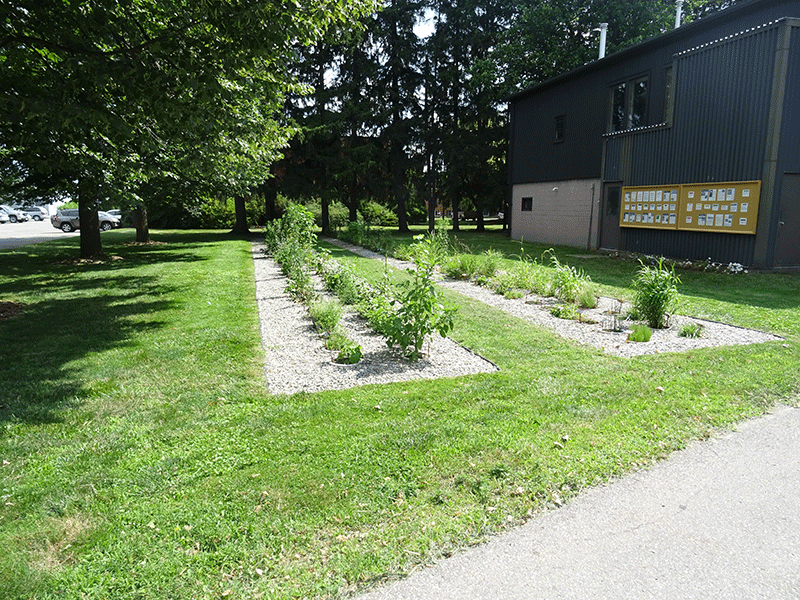A garden full of weeds
PROMOTING WEED IDENTIFICATION AND CONTROL
WHEN IT COMES to weeds, Dave Bilyea strongly believes in the adage keep your friends close, and your enemies closer.
PHOTO: WEED IDENTIFICATION GARDEN AT THE UNIVERSITY OF GUELPH RIDGETOWN CAMPUS.

In fact, as a weed management specialist for the University of Guelph Ridgetown Campus, he practices it every time he gets out the hose to water the 200 species of weeds under his watch in the Weed Identification Garden at the University of Guelph Ridgetown Campus.
The garden provides a place where those popular and lesser-known weeds (except for hazardous ones, such as poison ivy and giant hogweed) can be displayed in a controlled environment. In two rows with a grass walkway in between, each weed species is planted in cement tiles to contain it, and surrounded with crushed stone for ease of maintenance. An information board near the garden helps explain current Ontario weed alerts, and gives a bit of history about them.
Some may find it strange that weeds — a.k.a “the enemies” — are actually encouraged to grow on an agricultural campus. After all, research by Plant Agriculture professor Clarence Swanton (co-founder of the garden) and others points to potential yield losses due to weeds by as much as 50 per cent, depending on the species and conditions. They out-compete commercial crops for nutrients, water, and light, not to mention causing a mess at harvest when they get caught up in equipment.
Indeed, in late July, the Ontario Federation of Agriculture (OFA) was continuing to remind farmers of the need to control weeds, particularly the nasty ones. “Noxious weeds are more than an inconvenience,” said OFA board member Bruce Webster. “They can cause damage and loss to crops, seriously affect livestock, invade natural environments, and they can be extremely toxic to humans.”
But to fight your enemies, you need to be able to recognize them. And that’s where the weed identification garden — celebrating its 40th anniversary this year — comes in.
Bilyea says the garden is visited by the likes of growers, farm retailers, researchers, gardeners, students, and others with an interest in weeds that would typically be encountered in southwestern Ontario fields, roadsides, parks, and gardens.
Weeds that influence agricultural production are the prime focus of this garden. Among them, and some of their noteworthy properties follow.
• Common ragweed and giant ragweed. When they release their pollen, hay fever season begins for the next several weeks.
• Plantain and yarrow. Now common roadside weeds, they healed the wounds of soldiers from the time of the Roman Empire to the American Civil War.
• St. John’s Wort. Once used by ancient Druids to celebrate Pagan ceremonies, it causes an enhanced sunburn effect in animals that consume it.
• Jimsonweed. A common weed that, if consumed by animals or humans, can induce a hallucinogenic high similar to LSD.
• Wetland species such as purple Kloosestrife and Phragmites, and woodland invaders including garlic mustard and dog strangling vine.
• Burdock and wild carrot. These perimeter weeds can act as hosts for viruses that infect horticultural crops in fields and gardens.
• Quackgrass. It uses a toxin which suppresses other plants from establishing, a tactic called alleopathy.
Outside of agriculture, some weeds might also be called wildflowers or ornamentals, such as Black Eyed Susan, White Snakeroot, and Virgin’s Bower. Bilyea notes species such as milkweed and blueweed provide an important food source for insects — and even for humans, including Jerusalem artichoke, chicory, and lambsquarters. So he’s considering adding “wildflower” to the name of the weed identification garden, given that many of its patrons’ interests transcend farming.
“Any plant that’s out of place can be considered a weed,” says Bilyea. “That leaves the field wide open. Despite their reputation as a menace, many weeds do enhance mankind with beauty or truly useful properties.”
The weed garden is open for public viewing from early May until October. •

















